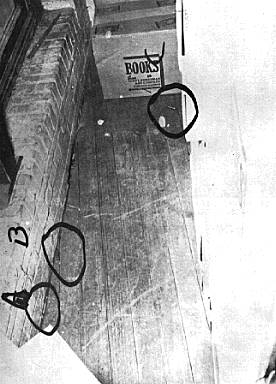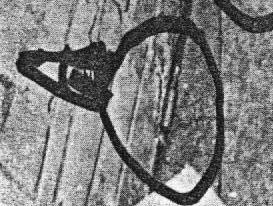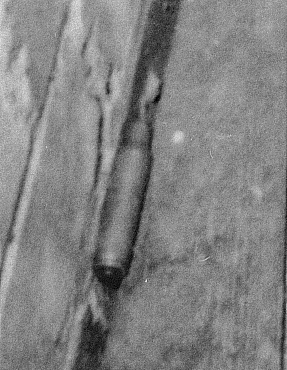
Dallas Police Evidence Tampering?
A Live Round in the Sniper's Nest?
A key part of the case against Lee Harvey Oswald is three spent cartridges found in the Sniper's Nest on the sixth floor of the School Book Depository in the wake of the shooting.
Discovered by Deputy Sheriff Luke Mooney, they were matched ballistically to Lee Oswald's gun to the exclusion of all other weapons. Mooney testified before the Warren Commission, and circled the three spent hulls on Warren Commission Exhibit 510 (right, above). So far so good.
But Noel Twyman, author of
the conspiracy tome Bloody Treason looked further, and made a startling discovery. One of the supposed "spent hulls" was in fact a live round! The blow-up at the left, below, shows what Twyman noticed. It certainly appears that the cartridge contains an unfired bullet.
 Twyman might have dismissed this, but it seemed to "corroborate" an earlier finding by conspiracy author Gary Shaw. Shaw had discovered a Dallas Police evidence sheet that listed two spent hulls and one live round — all matching Oswald's 6.5 mm. Mannlicher-Carcano (Bloody Treason, p. 112). Further, Twyman found a photo showing two spent hulls and one live round in the possession of the Dallas cops (Bloody Treason, p. 111).
Twyman might have dismissed this, but it seemed to "corroborate" an earlier finding by conspiracy author Gary Shaw. Shaw had discovered a Dallas Police evidence sheet that listed two spent hulls and one live round — all matching Oswald's 6.5 mm. Mannlicher-Carcano (Bloody Treason, p. 112). Further, Twyman found a photo showing two spent hulls and one live round in the possession of the Dallas cops (Bloody Treason, p. 111).
According to the testimony of the Dallas police, the live round in the chain of evidence was ejected from Oswald's rifle when it was discovered in the corner of the sixth floor opposite the Sniper's Nest. Of course, the document showing two spent hulls was later corrected to list three. But for conspiracists, early erroneous reports don't get "corrected." Rather, the nafarious forces of The Coverup swing into action and make the evidence fit the lone assassin scenario.
For Twyman, it all fit! The cops had actually found two spent hulls in the Sniper's nest, but when it was found that three bullets needed to have been fired from the Sniper's Nest, evidence was changed and tampered with. And Mooney must have lied.
The issue of "two versus three" spent rounds was dealt with by the Warren Commission, which had noticed the discrepancy. First, they questioned C. N. Dhority, Dallas Police Detective:
Mr. BALL. Now, did Captain Fritz give you some rifle shells to deliver to somebody?
Mr. DHORITY. Yes, sir.
Mr. BALL. About what time of the night or day was that?
Mr. DHORITY. I don't recall when it was, but, from his office there I took them up to the crime lab.
Mr. BALL. Were there three spent 6.5 rifle shells, is that right?
Mr. DHORITY. Yes, sir.
Mr. BALL. Did you return any shells to Captain Fritz?
Mr. DHORITY. Yes, sir.
Mr. BALL. All of them or one of them?
Mr. DHORITY. No; he told me to bring him one back.
Mr. BALL. You brought one back in an envelope?
Mr. DHORITY. Yes.
So for a time one of the spend rounds was separated from the others in the chain of evidence. J. C. Day, chief of the Dallas Police Identification Bureau, was also questioned about this issue:
Mr. BELIN. All right. You have mentioned these three hulls. Did you put any initials on those at all, any means of identification?
Mr. DAY. At that time they were placed in an envelope and the envelope marked. The three hulls were not marked at that time. Mr. Sims took possession of them.
Mr. BELIN. Well, did you at any time put any mark on the shells?
Mr. DAY. Yes, sir.
Mr. BELIN. All right. Let me first hand you what has been marked as "Commission Exhibit," part of "Commission Exhibit 543-544," and ask you to state if you know what that is.
Mr. DAY. This is the envelope the shells were placed in.
Mr. BELIN. How many shells were placed in that envelope?
Mr. DAY. Three.
Mr. BELIN. It says here that, it is written on here, "Two of the three spent hulls under window on sixth floor."
Mr. DAY. Yes, sir.
Mr. BELIN. Did you put all three there?
Mr. DAY. Three were in there when they were turned over to Detective Sims at that time. The only writing on it was, "Lieut. J. C. Day." Down here at the bottom.
Mr. BELIN. I see.
Mr. DAY. "Dallas Police Department," and the date.
Mr. BELIN. In other words, you didn't put the writing in that says, "Two of the three spent hulls."
Mr. DAY. Not then. About 10 o'clock in the evening this envelope came back to me with two hulls in it. I say it came to me, it was in a group of stuff, a group of evidence, we were getting ready to release to the FBI. I don't know who brought them back. Vince Drain, FBI, was present with the stuff, the first I noticed it. At that time there were two hulls inside.
I was advised the homicide division was retaining the third for their use. At that time I marked the two hulls inside of this, still inside this envelope.
Since Captain Fritz was Chief of the Homicide Bureau, Day is confirming that Fritz had one of the three hulls.
What did Fritz himself say? His affidavit is found in Warren Commission
Volume 7:
PRESIDENT'S COMMISSION
ON THE ASSASSINATION OF
PRESIDENT JOHN F. KENNEDY
AFFIDAVIT
STATE OF TEXAS,
County of Dallas, ss:
Before me, Mary Rattan, a Notary Public in and for said County,
State of Texas, on this day personally appeared J. W. Fritz,
Dallas Police Department, who, after being by me duly sworn, on
oath deposes and says: I wish to supplement the evidence given
by me on Wednesday, April 20, 1964, before the President's
Commission on the Assassination of President Kennedy, as
follows:
The Spent Rifle Hulls
Three spent rifle hulls were found under the window in the
southeast corner of the 6th floor of the Texas School Book
Depository Building, Dallas, Texas, on the afternoon of
November 22, 1963. When the officers called me to this
window, I asked them not to move the shells nor touch them until
Lt. Day of the Dallas Police Department could make pictures of
the hulls showing where they fell after being ejected from the rifle.
After the pictures were made, Detective R. M. Sims of the
Homicide Bureau, who was assisting in the search of building,
brought the three empty hulls to my office. These were delivered
to me in my office at the police headquarters. I kept the hulls in an
envelope in my possession and later turned them over to C. N.
Dhority of ,the Homicide Bureau and instructed him to take them
to Lt. Day of the Identification Bureau. I told Detective Dhority
that after these hulls were checked for prints to leave two of them
to be delivered to the FBI and to bring one of them to my office
to be used for comparison tests here in the office, as we were
trying to find where the cartridges had been bought. When
Detective Dhority returned from the Identification Bureau, he
returned the one empty hull which I kept in my possession.
Several days later, I believe on the night of November 27, Vince
Drain of the FBI called me at home about one o'clock in the
morning and said that the Commission wanted the other empty
hull and a notebook that belonged to Oswald. I came to the office
and delivered these things to the FBI. We have Mr. James P.
Hosty's receipt for these items in our report.
 So it seems that Twyman rediscovered something that the Warren Commission resolved in 1964. For a time, only two spent hulls and one live round (the one ejected from Oswald's rifle) were together. Fritz had the other spent hull.
So it seems that Twyman rediscovered something that the Warren Commission resolved in 1964. For a time, only two spent hulls and one live round (the one ejected from Oswald's rifle) were together. Fritz had the other spent hull.
Twyman's Rube Goldberg scenario has J. Edgar Hoover viewing the Zapruder film on the day after the assassination and deciding that three (not two) spent rounds were necessary in the Sniper's Nest (Bloody Treason, p. 95).
But in fact the Dallas Police were telling the press that there were three spent cartridges within an hour of their being discovered. At about 2:14 p.m., Central Time, NBC broadcast news that a rifle and three spent hulls had been found on the sixth floor of the Depository (NBC News "As It Happened," on The History Channel). The media were saying that because the cops had told them that. From the very beginning.
How Twyman could have overlooked these reports, which appeared in all the media on the afternoon of November 22nd, is a mystery.
But what about the supposed photographic corroboration of the "live round?" Dale Myers obtained a very high resolution scan of the "live round" from the Dallas Municipal Archives. I obtained a virtually identical scan, taken from a first generation print of the scene in the Sniper's nest. It shows a spent hull, and a piece of debris that gives the impression of being a glint off the metal of a bullet.
At right, above, is the same scan with the image sharpened with the Paintshop Pro "Sharpen More" filter. It makes it even clearer that it's a spent hull, and not a live round.
So it seems that, yet again, conspiracy authors have jumped to conclusions based on poor quality photographic evidence. This is reminiscent of the claim that Dallas cops tore out the license plate from a photo recovered from among Oswald's possessions showing the back of General Walker's house. This too, is a case of looking at poor quality photographs and jumping to conclusions.
James Olmstead supplied the blow up giving the impression of a "live round" in the Sniper's Nest, and the Dallas Municipal Archives suppled the high resolution blow up.
 Return to Kennedy Assassination Home Page
Return to Kennedy Assassination Home Page
 Twyman might have dismissed this, but it seemed to "corroborate" an earlier finding by conspiracy author Gary Shaw. Shaw had discovered a Dallas Police evidence sheet that listed two spent hulls and one live round — all matching Oswald's 6.5 mm. Mannlicher-Carcano (Bloody Treason, p. 112). Further, Twyman found a photo showing two spent hulls and one live round in the possession of the Dallas cops (Bloody Treason, p. 111).
Twyman might have dismissed this, but it seemed to "corroborate" an earlier finding by conspiracy author Gary Shaw. Shaw had discovered a Dallas Police evidence sheet that listed two spent hulls and one live round — all matching Oswald's 6.5 mm. Mannlicher-Carcano (Bloody Treason, p. 112). Further, Twyman found a photo showing two spent hulls and one live round in the possession of the Dallas cops (Bloody Treason, p. 111).

 So it seems that Twyman rediscovered something that the Warren Commission resolved in 1964. For a time, only two spent hulls and one live round (the one ejected from Oswald's rifle) were together. Fritz had the other spent hull.
So it seems that Twyman rediscovered something that the Warren Commission resolved in 1964. For a time, only two spent hulls and one live round (the one ejected from Oswald's rifle) were together. Fritz had the other spent hull.